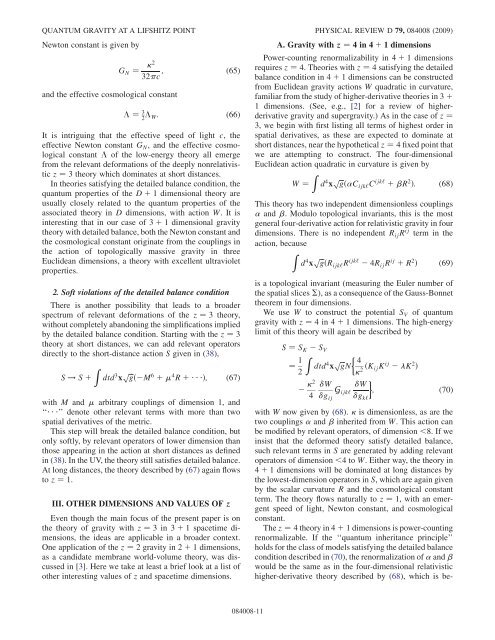Quantum gravity at a Lifshitz point
Quantum gravity at a Lifshitz point
Quantum gravity at a Lifshitz point
Create successful ePaper yourself
Turn your PDF publications into a flip-book with our unique Google optimized e-Paper software.
QUANTUM GRAVITY AT A LIFSHITZ POINT PHYSICAL REVIEW D 79, 084008 (2009)Newton constant is given byG N ¼and the effective cosmological constant232c ; (65) ¼ 3 2 W: (66)It is intriguing th<strong>at</strong> the effective speed of light c, theeffective Newton constant G N , and the effective cosmologicalconstant of the low-energy theory all emergefrom the relevant deform<strong>at</strong>ions of the deeply nonrel<strong>at</strong>ivisticz ¼ 3 theory which domin<strong>at</strong>es <strong>at</strong> short distances.In theories s<strong>at</strong>isfying the detailed balance condition, thequantum properties of the D þ 1 dimensional theory areusually closely rel<strong>at</strong>ed to the quantum properties of theassoci<strong>at</strong>ed theory in D dimensions, with action W. Itisinteresting th<strong>at</strong> in our case of 3 þ 1 dimensional <strong>gravity</strong>theory with detailed balance, both the Newton constant andthe cosmological constant origin<strong>at</strong>e from the couplings inthe action of topologically massive <strong>gravity</strong> in threeEuclidean dimensions, a theory with excellent ultravioletproperties.2. Soft viol<strong>at</strong>ions of the detailed balance conditionThere is another possibility th<strong>at</strong> leads to a broaderspectrum of relevant deform<strong>at</strong>ions of the z ¼ 3 theory,without completely abandoning the simplific<strong>at</strong>ions impliedby the detailed balance condition. Starting with the z ¼ 3theory <strong>at</strong> short distances, we can add relevant oper<strong>at</strong>orsdirectly to the short-distance action S given in (38),S ! S þ Z dtd 3 px ffiffiffi g ð M 6 þ 4 R þÞ; (67)with M and arbitrary couplings of dimension 1, and‘‘’’ denote other relevant terms with more than twosp<strong>at</strong>ial deriv<strong>at</strong>ives of the metric.This step will break the detailed balance condition, butonly softly, by relevant oper<strong>at</strong>ors of lower dimension thanthose appearing in the action <strong>at</strong> short distances as definedin (38). In the UV, the theory still s<strong>at</strong>isfies detailed balance.At long distances, the theory described by (67) again flowsto z ¼ 1.III. OTHER DIMENSIONS AND VALUES OF zEven though the main focus of the present paper is onthe theory of <strong>gravity</strong> with z ¼ 3 in 3 þ 1 spacetime dimensions,the ideas are applicable in a broader context.One applic<strong>at</strong>ion of the z ¼ 2 <strong>gravity</strong> in 2 þ 1 dimensions,as a candid<strong>at</strong>e membrane world-volume theory, was discussedin [3]. Here we take <strong>at</strong> least a brief look <strong>at</strong> a list ofother interesting values of z and spacetime dimensions.A. Gravity with z ¼ 4 in 4 þ 1 dimensionsPower-counting renormalizability in 4 þ 1 dimensionsrequires z ¼ 4. Theories with z ¼ 4 s<strong>at</strong>isfying the detailedbalance condition in 4 þ 1 dimensions can be constructedfrom Euclidean <strong>gravity</strong> actions W quadr<strong>at</strong>ic in curv<strong>at</strong>ure,familiar from the study of higher-deriv<strong>at</strong>ive theories in 3 þ1 dimensions. (See, e.g., [2] for a review of higherderiv<strong>at</strong>ive<strong>gravity</strong> and super<strong>gravity</strong>.) As in the case of z ¼3, we begin with first listing all terms of highest order insp<strong>at</strong>ial deriv<strong>at</strong>ives, as these are expected to domin<strong>at</strong>e <strong>at</strong>short distances, near the hypothetical z ¼ 4 fixed <strong>point</strong> th<strong>at</strong>we are <strong>at</strong>tempting to construct. The four-dimensionalEuclidean action quadr<strong>at</strong>ic in curv<strong>at</strong>ure is given byW ¼ Z d 4 px ffiffiffi g ðCijk‘ C ijk‘ þ R 2 Þ: (68)This theory has two independent dimensionless couplings and . Modulo topological invariants, this is the mostgeneral four-deriv<strong>at</strong>ive action for rel<strong>at</strong>ivistic <strong>gravity</strong> in fourdimensions. There is no independent R ij R ij term in theaction, becauseZd 4 px ffiffiffi g ðRijk‘ R ijk‘ 4R ij R ij þ R 2 Þ (69)is a topological invariant (measuring the Euler number ofthe sp<strong>at</strong>ial slices ), as a consequence of the Gauss-Bonnettheorem in four dimensions.We use W to construct the potential S V of quantum<strong>gravity</strong> with z ¼ 4 in 4 þ 1 dimensions. The high-energylimit of this theory will again be described byS ¼ S K S V¼ 1 Zdtd 4 x ffiffiffi p 4g N2 2 ðK ijK ij 24K 2 ÞW WGg ijk‘ ; (70)ij g k‘with W now given by (68). is dimensionless, as are thetwo couplings and inherited from W. This action canbe modified by relevant oper<strong>at</strong>ors, of dimension



![arXiv:1001.0993v1 [hep-ph] 6 Jan 2010](https://img.yumpu.com/51282177/1/190x245/arxiv10010993v1-hep-ph-6-jan-2010.jpg?quality=85)


![arXiv:1008.3907v2 [astro-ph.CO] 1 Nov 2011](https://img.yumpu.com/48909562/1/190x245/arxiv10083907v2-astro-phco-1-nov-2011.jpg?quality=85)







![arXiv:1002.4928v1 [gr-qc] 26 Feb 2010](https://img.yumpu.com/41209516/1/190x245/arxiv10024928v1-gr-qc-26-feb-2010.jpg?quality=85)
![arXiv:1206.2653v1 [astro-ph.CO] 12 Jun 2012](https://img.yumpu.com/39510078/1/190x245/arxiv12062653v1-astro-phco-12-jun-2012.jpg?quality=85)
